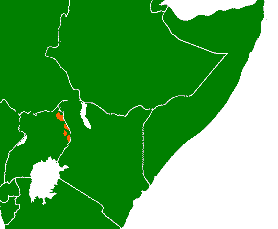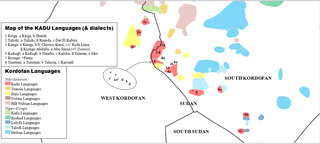
The Afroasiatic languages, also known as Hamito-Semitic or Semito-Hamitic, are a language family of about 400 languages spoken predominantly in West Asia, North Africa, the Horn of Africa, and parts of the Sahara and Sahel. Over 500 million people are native speakers of an Afroasiatic language, constituting the fourth-largest language family after Indo-European, Sino-Tibetan, and Niger–Congo. Most linguists divide the family into six branches: Berber, Chadic, Cushitic, Egyptian, Semitic, and Omotic. The vast majority of Afroasiatic languages are considered indigenous to the African continent, including all those not belonging to the Semitic branch.

The Cushitic languages are a branch of the Afroasiatic language family. They are spoken primarily in the Horn of Africa, with minorities speaking Cushitic languages to the north in Egypt and Sudan, and to the south in Kenya and Tanzania. As of 2012, the Cushitic languages with over one million speakers were Oromo, Somali, Beja, Afar, Hadiyya, Kambaata, and Sidama.

The Nilo-Saharan languages are a proposed family of African languages spoken by somewhere around 70 million speakers, mainly in the upper parts of the Chari and Nile rivers, including historic Nubia, north of where the two tributaries of the Nile meet. The languages extend through 17 nations in the northern half of Africa: from Algeria to Benin in the west; from Libya to the Democratic Republic of the Congo in the centre; and from Egypt to Tanzania in the east.

The Omotic languages are a group of languages spoken in southwestern Ethiopia, in the Omo River region and southeastern Sudan in Blue Nile State. The Geʽez script is used to write some of the Omotic languages, the Latin script for some others. They are fairly agglutinative and have complex tonal systems. The languages have around 7.9 million speakers. The group is generally classified as belonging to the Afroasiatic language family, but this is disputed by some.
Christopher Ehret, who currently holds the position of Distinguished Research Professor at UCLA, is an American scholar of African history and African historical linguistics particularly known for his efforts to correlate linguistic taxonomy and reconstruction with the archeological record. He has published ten books, most recently History and the Testimony of Language (2011) and A Dictionary of Sandawe (2012), the latter co-edited with his wife, Patricia Ehret. He has written around seventy scholarly articles on a wide range of historical, linguistic, and anthropological subjects. These works include monographic articles on Bantu subclassification; on internal reconstruction in Semitic; on the reconstruction of proto-Cushitic and proto-Eastern Cushitic; and, with Mohamed Nuuh Ali, on the classification of the Soomaali languages. He has also contributed to a number of encyclopedias on African topics and on world history.
The Kujargé language is spoken in seven villages in eastern Chad near Jebel Mirra, and in villages scattered along the lower Wadi Salih and Wadi Azum in Darfur, Sudan. It is estimated to have about 1,000 speakers.

The Kuliak languages, also called the Rub languages, are a group of languages spoken by small relict communities in the mountainous Karamoja region of northeastern Uganda.
Lowland East Cushitic is a group of roughly two dozen diverse languages of the Cushitic branch of the Afro-Asiatic family. Its largest representatives are Oromo and Somali.
The South Cushitic or Rift languages of Tanzania are a branch of the Cushitic languages. The most numerous is Iraqw, with half a million speakers. Scholars believe that these languages were spoken by Southern Cushitic agro-pastoralists from Ethiopia, who began migrating southward into the Great Rift Valley in the third millennium BC.

The Kadu languages, also known as Kadugli–Krongo or Tumtum, are a small language family of the Kordofanian geographic grouping, once included in Niger–Congo. However, since Thilo Schadeberg (1981), Kadu is widely seen as Nilo-Saharan. Evidence for a Niger-Congo affiliation is rejected, and a Nilo-Saharan relationship is controversial. A conservative classification would treat the Kadu languages as an independent family.
Proto-Afroasiatic (PAA), also known as Proto-Hamito-Semitic, Proto-Semito-Hamitic, and Proto-Afrasian, is the reconstructed proto-language from which all modern Afroasiatic languages are descended. Though estimations vary widely, it is believed by scholars to have been spoken as a single language around 12,000 to 18,000 years ago, that is, between 16,000 and 10,000 BC. Although no consensus exists as to the location of the Afroasiatic homeland, the putative homeland of Proto-Afroasiatic speakers, the majority of scholars agree that it was located within a region of Northeast Africa.

The West Chadic languages of the Afro-Asiatic family are spoken principally in Niger and Nigeria. They include Hausa, the most populous Chadic language and a major language of West Africa.

The South Bauchi languages are a branch of West Chadic languages that are spoken in Bauchi State and Plateau State, Nigeria.

The Talodi–Heiban languages are a proposed branch of the hypothetical Niger–Congo family, spoken in the Nuba Mountains of Sudan. The Talodi and Heiban languages are thought to be distantly related by Dimmendaal, though Glottolog 4.4 does not accept the unity of Talodi–Heiban pending further evidence.
Proto-Berber or Proto-Libyan is the reconstructed proto-language from which the modern Berber languages descend. Proto-Berber was an Afroasiatic language, and thus its descendant Berber languages are cousins to the Egyptian language, Cushitic languages, Semitic languages, Chadic languages, and the Omotic languages.

The Proto-Afroasiatic homeland is the hypothetical place where speakers of the Proto-Afroasiatic language lived in a single linguistic community, or complex of communities, before this original language dispersed geographically and divided into separate distinct languages. Afroasiatic languages are today mostly distributed in parts of Africa, and Western Asia.
Polci is an Afro-Asiatic language of Bauchi State, Nigeria. It is part of the Barawa cluster, which is in turn part of the West Chadic language family.

The Hausa–Gwandara languages of the Afro-Asiatic family are spoken principally in Niger and Nigeria. They include Gwandara and Hausa, the most populous Chadic language and a major language of West Africa.
Herrmann Rudolf Jungraithmayr is an Austrian Africanist and retired university professor. Until 1996, he was the chair of African linguistics at the Johann Wolfgang Goethe University in Frankfurt am Main, Germany.
Proto-Niger–Congo is the hypothetical reconstructed proto-language of the proposed Niger–Congo language family.











